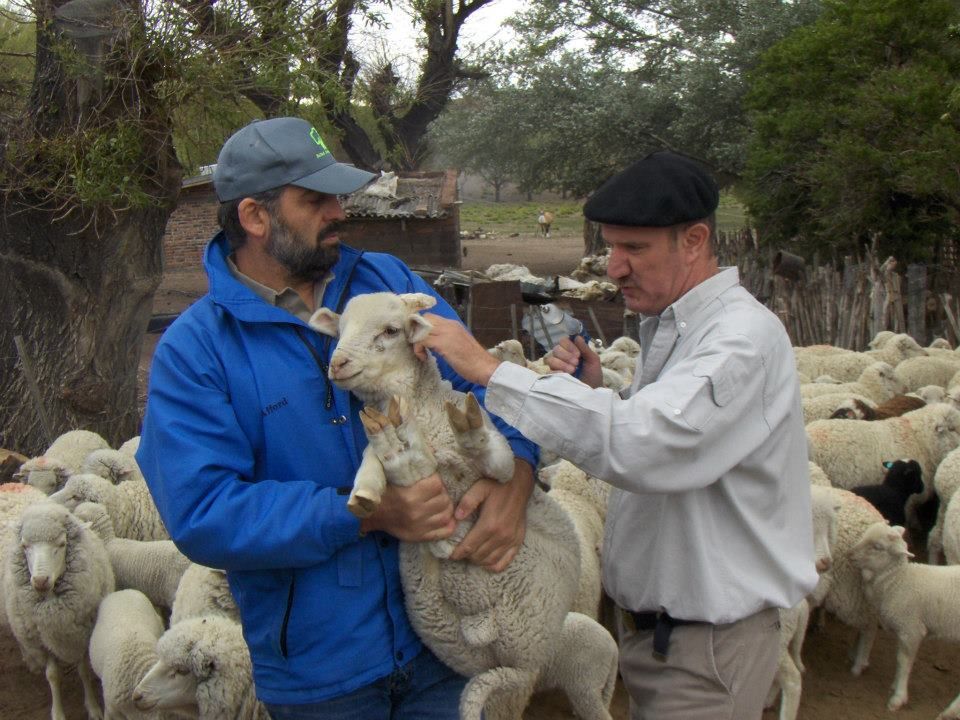Vaccination with EG95 against ovine cystic echinococcosis in the province of Río Negro: analysis of 12 years of work
DOI:
https://doi.org/10.19137/cienvet202224209Keywords:
Echinococcosis, Epidemiology, Vaccine, SheepAbstract
Cystic echinococcosis (CE) is a zoonosis caused by species of the complex Echinococcus granulosus, sensu lato in their larval stage. It is an endemic disease in the province of Río Negro, where lamb vaccination with EG95 was incorporated in 2009 with very good results: in fact, it contributed to a significant drop in prevalence of infection in diverse hosts. However, impact studies have revealed the need to improve understanding of local epidemiology. The objective was to identify causes which can still generate infection in dogs. In indigenous reserves comprised within the area of lamb vaccination with 3 doses of EG95, prevalence in adult caprines and ovines was determined by necropsy and serology (ELISA). Through serology, infection rates in vaccinated and non-vaccinated ovines were significantly different (p= 0.0004), as well as between non-vaccinated ovines and goats (p= 0.0013); on the other hand, infection rate differences between vaccinated sheep and non-vaccinated goats turned out non-significant (p= 0.254). Through necropsy, such difference between vaccinated and non-vaccinated ovines turned out significant (p= 0.0016); between non-vaccinated ovines and non-vaccinated goats, it proved non-significant (p= 0.23). With reference to epidemiology and control along the period 2018- 2022, vaccination strategy was maintained, and 2 extra deworming tasks were introduced, performed by the vaccination team. Assessment of animal slaughter for consumption in 41 producers showed that 21 of them slaughter a monthly average of 18 goats, and 36 in all slaughter 35 old sheep. Design and implementation of programme resulted cost-effective, since it was possible to maintain them over time, with clear impact on prevalence decrease in diverse hosts
Downloads
References
2. Pavletic, CF, Larrieu E, Guarnera EA, Casas N, et al. Cystic echinococcosis in South America: a call for action. Rev. Panam, Salud Publica. 2017; 21,41:e42.
3. Mujica G, Uchiumi L, Araya D, Salvitti JC, et al. Diagnosis, Treatment, Surveil-lance and Control of Cystic echinococcosis in the Province of Rio Negro: “One-Health” Model. Parasitologia. 2021; (4): 177-187.
4. Larrieu E, Uchiumi L, Salvitti JC, Sobrino M, Panomarenko O, et al. Epidemiology, diagnosis, treatment and follow up of cystic echinococcosis in asymptomatic carriers. Trans. R. Soc. Trop. Med. Hyg. 2019; 113(2),74-80.
5. Larrieu E, Mujica G, Gaucci C, Vizcaychipi K, Poggio TV, et al. Pilot field trial of the EG95 vaccine against ovine cystic echinococcosis in Rio Negro, Argentina: second study of impact. PLoS Negl. Trop. Dis. 2015; e0004134, 1:10.
6. Larrieu E, Mujica G, Araya D, Labanchi JL, Herrero E, et al.. Pilot field trial of the EG95 vaccine against ovine cystic echinococcosis in Rio Negro, Argentina: 8 years of work. 2018; Acta Trop. 18,191:1-7.
7. Sykes AI, Larrieu E, Poggio TV, Céspedes G, Mujica G, et al. Modelling diagnostics for Echinococcus granulosus surveillance in sheep using Latent Class Analysis: Argentina as a case study. One Health 2021; 4,14:100359.
8. Larrieu E. Manual de Epidemiologia y Salud Pública Veterinaria. Editorial UNRN, Rio Negro, Argentina. 2021.
9. Larrieu E, Gavidia CM, Lightowlers MW. Control of cystic echinococcosis: Background and prospects. Zoonoses Public. Health. 2019; 66(8): 889-899.
10. Torgerson PR. Mathematical models for the control of cystic echinococcosis. Parasitology Int. 2006; 55: 253-8.
11. Poggio TV, Jensen O, Mossello M, Iriarte J, Avila HG, et al. Serology and longevity of immunity against Echinococcus granulosus in sheep and llama induced by an oil-based EG95 vaccine. Parasite Immunol. 2016; 38(8),496-502.
12. Amarir F, Rhalem A, Sadak A, Raes M, Oukessou M, et al. Control of cystic echinococcosis in the Middle Atlas, Morocco: Field evaluation of the EG95 vaccine in sheep and cesticide treatment in dogs. PLoS Negl. Trop. Dis. 2021; 15(3),e0009253.
13. Sanchez L, Mayta H, Jara LM, Verástegui M, Gilman RH, et al. Echinococcus granulosus sensu stricto and E. canadensis are distributed in livestock of highly endemic area in the Peruvian highlands. Acta Trop. 2022; 225,106178.
14. Soriano SV, Pierangeli NB, Pianciola L, Mazzeo M, Lazzarini LE, Molecular characterization of Echinococcus isolates indicates goats as reservoir for Echinococcus canadensis G6 genotype in Neuquén, Patagonia Argentina. Parasitol. Int. 2006; 59(4),626-8.
15. Cucher MA, Macchiaroli N, Baldi G, Camicia F, Prada L, Maldonado L, et al. Cystic echinococcosis in South America: systematic review of species and genotypes of Echinococcus granulosus sensu lato in humans and natural domestic hosts. Trop. Med. Int. Health. 2016; 21(2),166-75.

Downloads
Published
Issue
Section
License
Al momento de enviar sus contribuciones, los colaboradores deberán declarar , de manera fehaciente, que poseen el permiso del archivo o repositorio donde se obtuvieron los documentos que se anexan al trabajo, cualquiera sea su formato (manuscritos inéditos, imágenes, archivos audiovisuales, etc.), permiso que los autoriza a publicarlos y reproducirlos, liberando a la revista y sus editores de toda responsabilidad o reclamo de terceros , los autores deben adherir a la licencia Creative Commons denominada “Atribución - No Comercial CC BY-NC-SA”, mediante la cual el autor permite copiar, reproducir, distribuir, comunicar públicamente la obra y generar obras derivadas, siempre y cuando se cite y reconozca al autor original. No se permite, sin embargo, utilizar la obra con fines comerciales.







.jpg)

4.png)


7.png)



